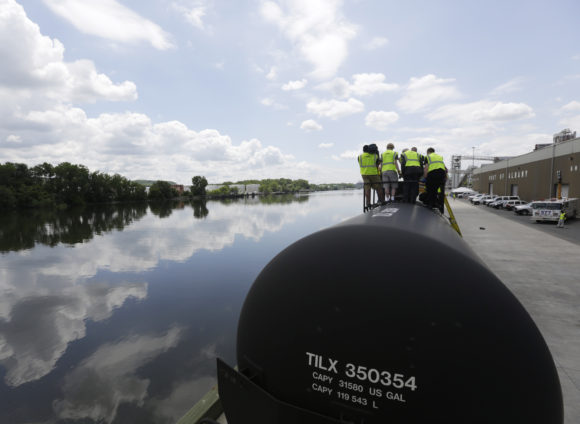The Hudson River may still become a major corridor for the shipment of thick, tar sands oil from Canada despite moves last year by New York officials that attempted to halt those efforts.
At issue is a key air permit needed by an oil terminal in Albany to transfer heavy crude from railcars to barges that would travel down the Hudson and past some of New Jersey’s most densely populated communities on their way to refineries.
Although oil spills by tankers have decreased in recent decades, environmentalists and some local officials say heavy crude represents a significant threat to the Hudson because it is extremely difficult, if not impossible, to fully clean up.
Many believed the proposal by Global Partners LP was defeated last year when the New York Department of Environmental Conservation (DEC) reversed its original approval of the plan after the agency received considerable backlash. But the permit issue is now slowly going through New York courts.
“A lot of people thought it was the end of the story, but it’s really just in a state of limbo,” said Kate Hudson, a lawyer with the advocacy group Hudson Riverkeeper. “It’s still a real threat.”
DEC spokesman said that the agency is waiting on the courts to hear its appeal.
In New Jersey, Assembly Speaker Vincent Prieto, D-Secaucus, called on Governor Christie to conduct a comprehensive review of the state’s readiness to handle spills and emergencies. The Jersey side of the Hudson has seen thousands of new residents in the past 25 years as the waterfront has been transformed from a fading industrial hub to a high-end bedroom community.
Bob Considine, spokesman for the New Jersey Department of Environmental Protection, said the agency is monitoring the developments but won’t formally weigh in because “we have no jurisdiction.”
All oil tankers and barges that serve U.S. ports have been required since last year to have a double hull, one of many reforms spurred by the 1989 Exxon Valdez spill.
A double hull was key in preventing a disaster on the Hudson in 2012 when the Stena Primorsk, the first tanker carrying light crude out of Albany, ran aground and ruptured its outer hull. None of the 12 million gallons of oil it carried spilled because the inner hull was not breached.
Topics Trends New York Energy Oil Gas New Jersey
Was this article valuable?
Here are more articles you may enjoy.



 Viewpoint: Deepfake Fraud Is On the Rise. Here’s How Insurers Can Respond
Viewpoint: Deepfake Fraud Is On the Rise. Here’s How Insurers Can Respond  With American Mobile Cancellations, Florida Mobile Home Market Has ‘Fallen Apart’
With American Mobile Cancellations, Florida Mobile Home Market Has ‘Fallen Apart’  Deere Retreats From Diversity Measures After Online Attacks
Deere Retreats From Diversity Measures After Online Attacks  Insurers Settle With Hotel in Case of Woman Videotaped in the Shower
Insurers Settle With Hotel in Case of Woman Videotaped in the Shower 


